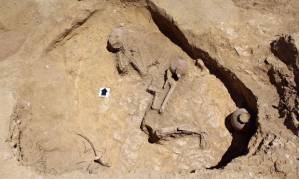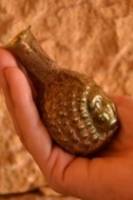Вход / Регистрация
22.12.2024, 23:58
Главная » 2015 Июнь 11 » Dazzling jewels from an Ethiopian grave reveal 2,000-year-old link to Rome
14:57 Dazzling jewels from an Ethiopian grave reveal 2,000-year-old link to Rome |
 Spectacular 2,000-year-old treasures from the Roman empire and the Aksumite kingdom, which ruled parts of north-east Africa for several centuries before 940AD, have been discovered by British archaeologists in northern Ethiopia. Louise Schofield, a former British Museum curator, headed a major six-week excavation of the ancient city of Aksum where her team of 11 uncovered graves with "extraordinary” artefacts dating from the first and second centuries. They offer evidence that the Romans were trading there hundreds of years earlier than previously thought. Schofield told the Observer: "Every day we had shed-loads of treasure coming out of all the graves. I was blown away: I’d been confident we’d find something, but not on this scale.” She was particularly excited about the grave of a woman she has named "Sleeping Beauty”. The way the body and its grave goods had been positioned suggest that she had been beautiful and much-loved. Schofield said: "She was curled up on her side, with her chin resting on her hand, wearing a beautiful bronze ring. She was buried gazing into an extraordinary Roman bronze mirror. She had next to her a beautiful and incredibly ornate bronze cosmetics spoon with a lump of kohl eyeliner.” The woman was also wearing a necklace of thousands of tiny beads, and a beaded belt. The quality of the jewellery suggests that she was a person of very high status, able to command the very best luxurious goods. Other artefacts with her include Roman glass vessels – two perfectly preserved drinking beakers and a flask to catch the tears of the dead. There was also a clay jug. Schofield hopes that its contents can be analysed. She believes it would have contained food and drink for the afterlife. Although "Sleeping Beauty” was covered only with soil, her grave was cut into a rock overhang, which is why the finds survived intact. The team also found buried warriors, with each skeleton wearing large iron bangles. They may have been killed in nearby battlefields. Other finds include another female skeleton with a valuable necklace of 1,065 coloured glass beads, and, elsewhere, a striking glass perfume flask. In 2012, the Observer reported that Schofield’s earlier excavations in the region had discovered an ancient goldmine that may solve the mystery of from where the Queen of Sheba of biblical legend derived her fabled treasures. Aksum, the capital of the Aksumite kingdom, was a major trading power from the first to the seventh centuries, linking the Roman Empire and India. Aksumites were a literate people. Yet little is known about this so-called "lost”’ civilisation. "Ethiopia is a mysterious place steeped in legend, but nobody knows very much about it,” said Schofield. "We know from the later Aksumite period – the fourth and fifth centuries, when they adopted Christianity – that they were trading very intensely with Rome. But our finds are from much earlier. So it shows that extraordinarily precious things were travelling from the Roman Empire through this region centuries before.” In return, the Romans sought ivory tusks, frankincense and metals. Schofield’s excavations also found evidence of iron working. The finds will go to a new German-funded museum, opening in October. Schofield hopes to organise a loan to the British Museum, but first the finds must be conserved: the mirror, for example, is corroded and slightly buckled. Germany is sending nine conservators. Excavations were paid for by the Sainsbury family’s Headley Trust and the Tigray Trust, a charity that promotes sustainability in the region; and by individual donations. |
| Категория: Archaeology | Просмотров: 1176 | |
| Всего комментариев: 0 | |




